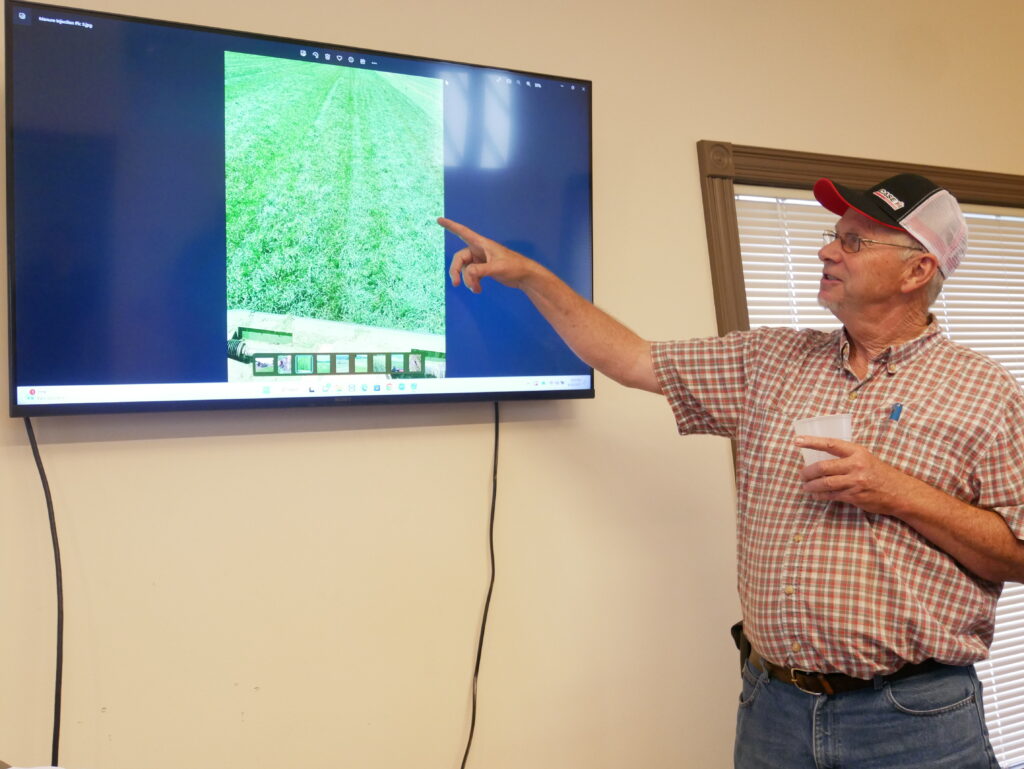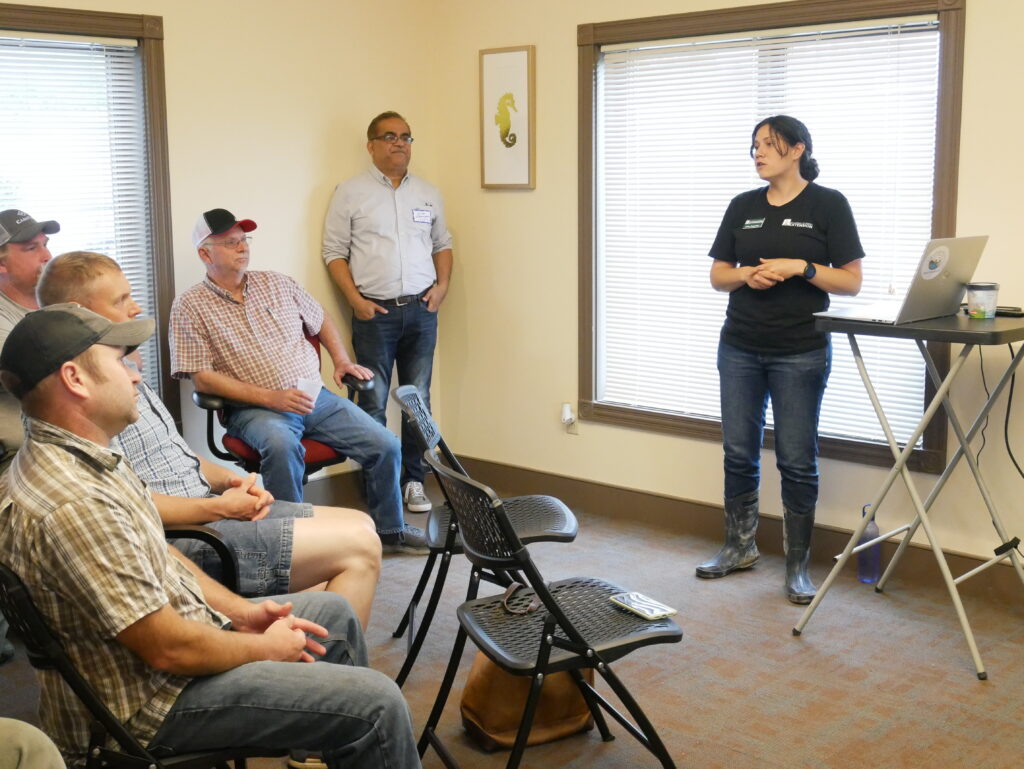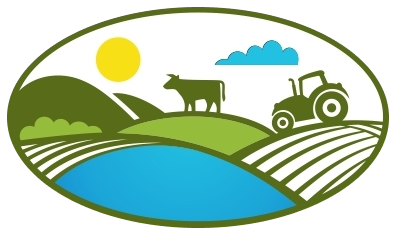
Injecting manure into a hayfield or other perennial crop is a terrifying prospect for many farmers.
“Farmers work so hard to create grass ground to be smooth, level, and minimally compacted,” Ryan Carabeau of Conant’s Riverside Farm in Richmond said. “To even consider going in with a tool that is lifting, cutting, and moving stuff around…it would make the people who follow that system with the mowers just shake in their boots thinking, ‘What rocks am I going to hit? What issues am I going to have?’”
For years farmers have been increasingly using manure injection equipment solely on their annual corn fields to reap the benefits of increased nutrient retention for cost savings and better yields. There are benefits to the environment, like reduced risk of odor and runoff into waterways.
“We injected ten days ago, and we got three inches of rain since, and I feel a whole lot better that I injected that manure rather than surface applied it,” Allan Brisson of Allandra Farm in Ferrisburgh shared at a recent Champlain Valley Farmer Coalition Farmers Connect meeting in Ferrisburgh.
The injector makes slots in the soil where manure is then inserted several inches below the soil surface. If rocks are turned up in the process, it’s not a problem at harvest time on a cornfield because the chopper is at least a foot off the ground. But, with a perennial crop, it’s a different story. Grasses can be clipped off as close as four inches.
“When you’re cutting grass, you’re vacuuming the field, whereas, with corn, we can carry over those obstacles,” said Jed Quesnel of Richville Farms in Shoreham. “We absolutely want to implement it, but we really have to get the tools in place to do it properly…The real cost of a rock could be upward of $30,000, and you could experience a week and a half of downtime, which might take tons of feed and make it garbage.”

But for Brisson, it’s more concerning to spread manure on perennial crops like it’s always been done – by broadcasting it from a tanker truck with a spreader bar from one center point across a span of 40 feet through the air onto the field below.
Brisson has been injecting manure on corn and grassland for several years and now exclusively injects nearly all the manure from his 1,000-cow dairy.
“When I see that picture of a tractor with a spreader bar, it’s disturbing to me. I was talking to my brother, and I said, ‘Why do we think it’s okay to spread 8,000 or 9,000 gallons of manure per acre on top of the ground?’ And he thought about it, and he goes, ‘It’s what we’ve been doing.’”
Brisson paused as he looked around the room at the 30 farmers and agriculture professionals who came to hear him and other industry experts speak at the Farmers Connect event.
“But there’s a better way.”
Benefits Backed by Science
In recent years, UVM Extension has increased its research on manure injection on hayfields. As a result, farmers like Brisson have successfully been experimenting to make it work.
A big driver is reducing phosphorus runoff. Historically, hayfields have been considered low-risk for phosphorus runoff from erosion, a significant contributor to water pollution, because the soil stays mostly in place. Yet, erosion isn’t the only reason for phosphorus loss on hay fields, and in Vermont, where there are more hay fields than annual crops, runoff can’t be ruled out.
“Phosphorus doesn’t move into the soil profile readily when surface applied. It will hang out on the surface, and when you have runoff, it will dissolve the phosphorus and carry dissolved phosphorus with it,” Abby Augarten, UVM Extension Agronomy Outreach Specialist, shared in her presentation at the Farmers Connect meeting. “That is one mode we see phosphorus leaving the field even if there isn’t any soil moving off that field.”
One way Vermont regulators and researchers measure the risk of phosphorus losses on fields is with the phosphorus index or P index. Agronomists calculate it in any field where nutrients are applied. It provides a numerical value that sums up the risk of phosphorus leaving a field in three ways: soil erosion, dissolved runoff, or sub-surface flow, such as via a tile drainage system. When the P index is zero to 50, it’s low-risk, but 51-80 is moderate-risk, 81-100 is high-risk, and more than 100 is very high. When it’s over 100, farmers aren’t allowed to apply any manure or fertilizer.
Augarten shared a recent modeling scenario in which UVM Extension compared what the P index would likely be after surface application of dairy manure versus manure injection. The scenario depicted a fall manure application on bare soil in between corn crops. In the example scenario, 8,000 gallons per acre of liquid dairy manure (5 to 10 percent dry matter) was applied, using book values estimated at 71 pounds per acre of P2O5. The surface application in the model showed a very high-risk P index.
“It’s a red flag. We’re going to have to make some switches to reduce that P index, so we’re in compliance with regulations,” Augarten said.
In contrast, the P index with manure injection was low risk.
“What the low phosphorus index tells us is that when we inject manure in the soil, we’re decreasing the risk that we’re going to have phosphorus moving with sediment, in dissolved form, or sub-surface flows,” Augarten said. “Manure injection is one way to build flexibility into your nutrient management plan and phosphorus index. While there are other tools, like increasing buffer strips or reducing the manure rate, injection is the management practice that takes it to the next level.”
Augarten says manure injection may reduce the P index on hayfields, but the impact is smaller than on corn fields, and more research is needed.

“We are still trying to capture actual, and not modeled, water quality impacts from grassland injection through rainfall simulators, but that has been less straightforward,” Augarten said.
Beyond environmental benefits and nutrient management flexibility, the benefit that convinces farmers to figure out manure injection on hayfields is the savings on commercial fertilizer.
Extension research shows that 95 percent of the ammonia nitrogen from liquid dairy manure (5 to 10 percent dry matter) is available to the crop when farmers inject it in the spring or summer. When manure is applied to the surface level only, it drops to 40 percent because the ammonia volatilizes.
“That’s why our nose curls up in the middle of the summer because we smell ammonia going out in the atmosphere, so if you keep it in the ground, you don’t smell it, and you know you’ve captured it,” Tom Eaton of Agricultural Consulting Services shared.
Eaton works with farmers like Brisson to create nutrient management plans to optimize crop yields and reduce environmental impacts. At Brisson’s farm, he’s calculated massive yearly savings in commercial fertilizer thanks to manure injection.
“Before manure injection, he was losing ammonia nitrogen, and he had to replace that,” Eaton said, who calculated the annual value of Allandra Farm’s manure at $205,978 or $21.10 per 1,000 gallons.
“If I’m losing 50 percent of that, or more, in the air, it’s over $100,000 I’m letting go,” Brisson said. “This is something that we all have had in our pocket, but by the way we were doing it, we were letting it get away, at least a portion of it, and there’s a way to do it and save it.”
Augarten shared a UVM Extension modeling scenario that backed up Brisson’s experience. The scenario looked at a field that requires 150 pounds of nitrogen per acre for optimal growth. The model showed manure injection of 8,000 gallons per acre in the spring/summer would provide a manure N-credit of approximately 100 pounds per acre from combined ammonium and organic nitrogen. Surface-applied manure would only provide approximately 50 pounds, leaving the farmer on the hook to fill a 100-pound gap per acre with commercial fertilizer compared to only 50 pounds with manure injection.
In addition to purchasing less commercial fertilizer, injection has increased Brisson’s profitability through the farm’s crop yields. He says he consistently harvests higher-quality crops from his hay and corn fields, making his dairy herd more productive and allowing him to sell excess crops.
“We went from a farm that was borderline on having enough feed to selling feed. All because of cover crops, no-till, and manure injection,” Brisson said.
What About the Rocks?
It was the make-or-break question for most farmers at the discussion.
Brisson solves the problem at his farm by pulling a 41-foot, 12.5-ton roller across the 1,500 acres of perennial grass he injects manure into.
“You give it a day or two to firm up before you roll it,” Brisson said. “It’ll squish it right back out again if you do it too early. When it hits a stone, it will put it down, and there might be a few it won’t put down, and you need to pick them up,” Brisson said to the group as they chuckled about the chore of picking up rocks. “Even if you have a field where you went out when it was a little too wet, you can make that field right again without having to reseed the whole field.”
Brisson shared pictures of injected grass he had pulled up by hand. It showed a thick layer of manure under it with white roots reaching through it. Above the surface, he says the grass has a clear color difference.
“The grass is almost blue because it’s getting nitrogen from manure injected in November. To me, it’s an indication of protein,” Brisson said.
Brisson’s set-up for manure injection includes several satellite pits away from his main farm. Employees watch over manure as it’s piped to remote fields instead of having to truck it. At the field, hoses connect to the manure injector equipped with 14 Dietrich shanks spaced two feet apart, pulled behind a tractor with a three-point hitch. Manure is injected at a depth of 3.5 inches.
“We typically put down 16,000 gallons per acre, and it’s neat and clean,” Brisson said.
The Dietrich shank injector system differs from the disk injector system, often called a pizza cutter, that’s commonly used in Vermont. The shank spreads manure out horizontally underground in addition to making vertical cuts.
“It’s about distribution – don’t expect much if you’re trying to shove manure into a small crack in the ground without any horizontal distribution; that’s where the Dietrich shank is starting to make more sense,” Eaton said.
There are also fewer hoses to contend with in the Dietrich shank system.
“The disk grassland injector, from the mechanics of it, it’s got a million hoses on it, and 14 hoses are enough to keep flowing, say nothing about a million,” Brisson said.
Brisson admits his set-up isn’t cheap – he’s invested hundreds of thousands of dollars between the roller, the injector, draglines, and satellite pits.
A group of problem-solvers, many farmers attending the meeting chimed in with ways they’ve introduced manure injection on hay fields at their farms.
Ryan Carabeau of Conant’s Riverside Farm in Richmond described how their farm took a first cutting from a hayfield, injected manure into the field, and then converted it to a corn field using no-till planting, so they didn’t have to worry about the roughness and rocks.
“We’d have to modify our system and dial it in before we even considered doing this into a hay crop and continuing to leave it as a hay crop,” Carabeau said.
Lorenzo Whitcomb of North Williston Cattle Company in Williston has been pulling a manure tanker that feeds into a Dietrich shank injector. Though it’s harder on the tractor and the field when compared to feeding the injector with a drag hose, it’s made manure injection more accessible.
Brendan Rowley of Rowley Brothers Farm in Milton, Vermont, agrees. He operates a custom manure application business in addition to working at his family’s dairy farm.
“I like that it’s a little bit lower pressure than the dragline system. If I get into it, it’ll be small-scale. A lot of what I do is for smaller farms, and the smaller guys still need service,” Rowley said.
Grants Make Accessing Tech Easier
As more Vermont farmers consider how to modify their cropping systems to reap the benefits of manure injection, several programs are available from the Vermont Agency of Agriculture to support the purchase of equipment.
- The Capital Equipment Assistance (CEAP) Program covers up to $60K or 90% of the cost of injection toolbars like the Dietrich shank. The deadline to apply is Nov. 1.
- The Farm Agronomic Practices (FAP) Program provides $10,000 of non-competitive funding per year to cover soil-based agronomic practices. The deadline to apply for fall practices is Aug. 1.
The Natural Resource Conservation Service (NRCS) also provides funding for manure injection.

Sonia Howlett, Agricultural Water Quality Program Coordinator for the Vermont Agency of Agriculture, Food and Markets, says farmers that apply for larger grants together often do well.
“We’ve seen farms that are very small that have said, we are all going to cover crop and do no-till, and we’ve had trouble getting access to the UVM no-till drill; let’s all pitch in for this one piece of equipment,” Howlett said.
As with most things, manure injection on grass and other perennial crops will look different at every farm, but there’s one thing these farmers all have in common: their desire to get better at what they do.
“Eventually, it’s probably going to be the golden standard, and if that’s the direction we’re heading, it’s good to learn about it now to get ahead of the game,” Rowley said.




